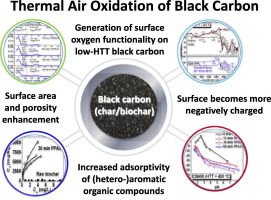Science of the Total Environment ( IF 9.8 ) Pub Date : 2017-11-10 , DOI: 10.1016/j.scitotenv.2017.11.008 Feng Xiao , Alemayehu H. Bedane , Julia Xiaojun Zhao , Michael D. Mann , Joseph J. Pignatello

|
In this study, we systematically investigated the effects of thermal air oxidation on the properties of biomass-derived black carbon (BC) made at carbonization temperatures (HTTs) of 300–700 °C. BC produced by including air in the carbonization step was found to have a low surface area and underdeveloped pore structure. Substantial changes of BC were observed after post-pyrolysis thermal air oxidation (PPAO). Well-carbonized BC samples made anoxically at relatively high HTTs (600 and 700 °C) showed, after PPAO, significant increases in N2 BET surface area (SA) (up to 700 times), porosity (< 60 Å) (up to 95 times), and adsorptivity (up to 120 times) of neutral organic species including two triazine herbicides and one natural estrogen. Partially carbonized BC made at a lower HTT (300 or 400 °C) showed moderate increases in these properties after PPAO, but a large increase in the intensity of Fourier transform infrared spectroscopy bands corresponding to various oxygen-containing functional groups. Well-carbonized BC samples, on the other hand, were deficient in surface oxygen functionality even after the PPAO treatment. Adsorption of the test organic compounds on BC generally trended with BET SA when it was less than 300 m2/g, but BET SA was poorly predictive of adsorption when it was greater than 300 m2/g. Overall, our results suggest that thermal reactions between molecular oxygen and BC 1) increase surface oxygen functionality more effectively for low-HTT than for high-HTT BC samples; 2) increase SA and porosity (< 60 Å) especially for high-HTT BC samples; and 3) create new adsorption sites and/or relieve steric restriction of organic molecules to micropores, thereby enhancing the adsorptivity of BC. These results will prove useful not only for understanding the fate of environmental BC but also in devising strategies for improving the practical performance of the engineered form of BC (i.e., biochar).
中文翻译:

热空气氧化会改变黑碳(炭/生物炭)的表面和吸附性能
在这项研究中,我们系统地研究了热空气氧化对在300–700°C的碳化温度(HTT)下制备的生物质衍生的黑碳(BC)性能的影响。发现在碳化步骤中通过包括空气而产生的BC具有低的表面积和不发达的孔结构。热解后热空气氧化(PPAO)后观察到BC的大量变化。PPAO后,在较高的高温下(600和700°C)无氧制备的碳化良好的BC样品显示N 2的显着增加BET表面积(SA)(最高达700倍),孔隙率(<60Å)(最高达95倍)和吸附性(最高达120倍),其中包括两种三嗪除草剂和一种天然雌激素。在较低的HTT(300或400°C)下制得的部分碳化的BC在PPAO后显示出这些性能的适度提高,但是与各种含氧官能团相对应的傅立叶变换红外光谱带的强度却大大提高。另一方面,即使经过PPAO处理,碳化良好的BC样品的表面氧官能度也不足。上BC测试有机化合物的吸附通常与BET SA趋势时,它是小于300米2 /克,BET但SA是预测不良吸附的,当它是大于300米2/G。总体而言,我们的结果表明,分子氧与BC之间的热反应1)对于低HTT的样品,其对表面氧的功能要比对高HTT的BC样品更有效。2)增加SA和孔隙率(<60Å),特别是对于高HTT BC样品;3)产生新的吸附位点和/或减轻有机分子对微孔的空间限制,从而增强BC的吸附性。这些结果将证明不仅对理解环境BC的命运有用,而且对于设计改善BC工程形式(即生物炭)的实际性能的策略也是有用的。



























 京公网安备 11010802027423号
京公网安备 11010802027423号